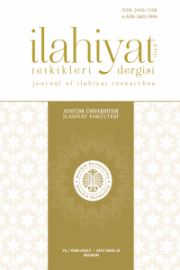Kur'ân Tercümelerinde İltifât Sanatının Çeviri Sorunu
Translation Problem of Iltifāt Art in Translation of Qur’ān
Author(s): Haşim ÖzdaşSubject(s): Theology and Religion, Islam studies, Translation Studies
Published by: Atatürk Üniversitesi İlahiyat Fakültesi
Keywords: Tafṣīr; Iltifāt; Meaning; Source Language; Target Language;
Summary/Abstract: Transitions are made between subject pronouns, tenses and numbers in Arabic language. This style change is frequently used in the Holy Qur’ān. Many Turkish translations of Holy Qur’ān are made without taking the target language into consideration one of which is the style change called as iltifāt in Arabic Language and Literature. As a result, this leads to the fact that the translations of verses cannot be completely understood by the readers. In this study, the iltifāt style in translation problems in translations of Qur’ān will be investigated. Since evaluating all Turkish translations of Qur’ān will exceed the limit of a single article, the abovementioned translation problem will be tried to be studied with investigating the Turkish translations of the works such as the tafsir called as Hak Dini Kur’an Dili (The Truth [God]'s Religion Quran's language) by Elmalılı Muhammed Hamdi Yazır, and Kur’an-ı Kerim Tefsiri (Tafsir of Holy Qur’ān) by Süleyman Ateş, and also Kur’an-ı Kerim Meali (Translation of the Holy Qur’ān) by Halil Altuntaş and Muzaffer Şahin, and Kur’an-ı Kerim Meali Anlam ve Yorum Merkezli Çeviri (Holy Qur’ān Translation, Meaning and Interpretation-Centred Translation) by Mustafa Öztürk.
Journal: İlahiyat Tetkikleri Dergisi
- Issue Year: 2020
- Issue No: 53
- Page Range: 93-113
- Page Count: 21
- Language: Turkish

